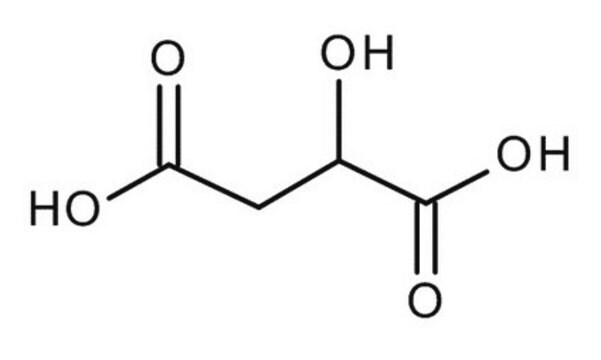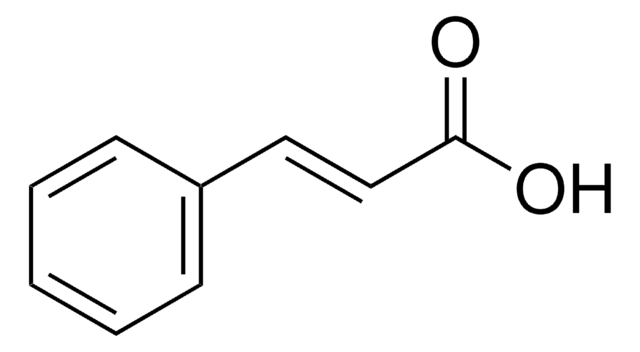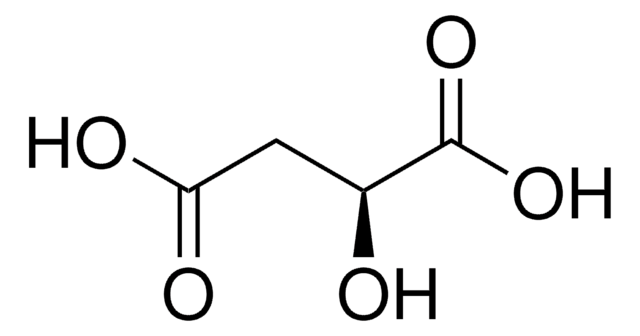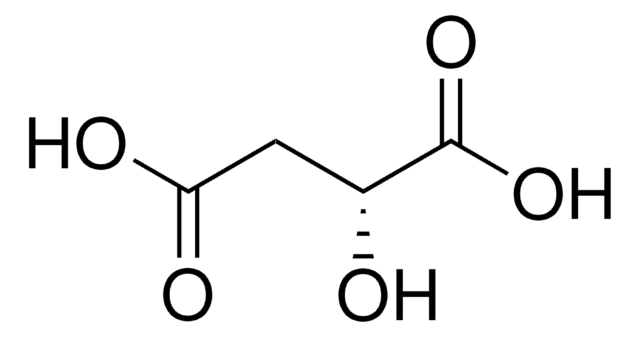Key Documents
W265501
DL-Malic acid
99%
Synonim(y):
(±)-2-Hydroxysuccinic acid, DL-Hydroxybutanedioic acid
About This Item
Polecane produkty
pochodzenie biologiczne
synthetic
Poziom jakości
klasa czystości
Kosher
zgodność regionalna
FDA 21 CFR 1084.1069
FDA 21 CFR 117
gęstość pary
4.6 (vs air)
ciśnienie pary
<0.1 mmHg ( 20 °C)
Próba
99%
temp. samozapłonu
644 °F
mp
131-133 °C (lit.)
rozpuszczalność
H2O: soluble 646.6 g/L at 20 °C
Zastosowanie
flavors and fragrances
Dokumentacja
see Safety & Documentation for available documents
alergen pokarmowy
no known allergens
Organoleptyczne
odorless
ciąg SMILES
OC(CC(O)=O)C(O)=O
InChI
1S/C4H6O5/c5-2(4(8)9)1-3(6)7/h2,5H,1H2,(H,6,7)(H,8,9)
Klucz InChI
BJEPYKJPYRNKOW-UHFFFAOYSA-N
Szukasz podobnych produktów? Odwiedź Przewodnik dotyczący porównywania produktów
Opis ogólny
Zastosowanie
- Tetra-Ln(3+)-Implanted Tellurotungstates Covalently Modified by dl-Malic Acid: Proton Conduction and Photochromic Properties.: This innovative study showcases dl-Malic acid as a key component in the synthesis of advanced tellurotungstates, contributing to notable enhancements in proton conduction and photochromic properties, which are critical for applications in smart materials and sensors (Niu et al., 2024).
- Direct regeneration of spent LiFePO(4) materials via a green and economical one-step hydrothermal process.: dl-Malic acid is utilized in a green chemistry approach for the direct regeneration of lithium iron phosphate (LiFePO4) materials, demonstrating a sustainable pathway for battery recycling and highlighting its importance in promoting environmental sustainability (Yang et al., 2023).
- Chitin Extracted from the Shell of Blue Swimming Crabs (Portunus pelagicus Linn.) Inhibits NF-kappaB p65 in Ethanol-Induced Gastric Ulcerative Wistar Rats.: In this research, dl-Malic acid serves as a catalyst in the extraction and functional activity testing of chitin, which is shown to have significant anti-inflammatory effects, suggesting its potential in pharmaceutical applications (Amelia et al., 2023).
- Manganese-Titanium Mixed Ion Sieves for the Selective Adsorption of Lithium Ions from an Artificial Salt Lake Brine.: Highlighting the application of dl-Malic acid in the synthesis of ion-exchange materials, this study points towards its utility in enhancing the selective adsorption properties of manganese-titanium mixed ion sieves, crucial for lithium recovery from brines (Ding et al., 2023).
Oświadczenie o zrzeczeniu się odpowiedzialności
Hasło ostrzegawcze
Warning
Zwroty wskazujące rodzaj zagrożenia
Zwroty wskazujące środki ostrożności
Klasyfikacja zagrożeń
Eye Irrit. 2
Kod klasy składowania
11 - Combustible Solids
Klasa zagrożenia wodnego (WGK)
WGK 1
Temperatura zapłonu (°F)
397.4 °F
Temperatura zapłonu (°C)
203 °C
Środki ochrony indywidualnej
dust mask type N95 (US), Eyeshields, Gloves
Wybierz jedną z najnowszych wersji:
Masz już ten produkt?
Dokumenty związane z niedawno zakupionymi produktami zostały zamieszczone w Bibliotece dokumentów.
Klienci oglądali również te produkty
Nasz zespół naukowców ma doświadczenie we wszystkich obszarach badań, w tym w naukach przyrodniczych, materiałoznawstwie, syntezie chemicznej, chromatografii, analityce i wielu innych dziedzinach.
Skontaktuj się z zespołem ds. pomocy technicznej








